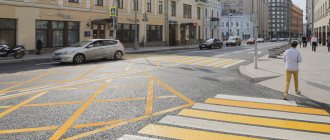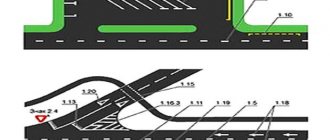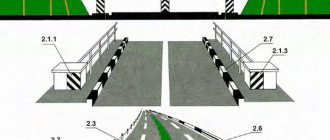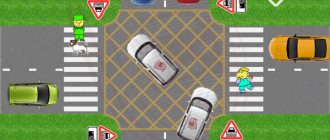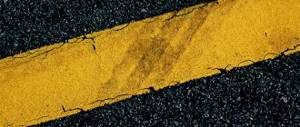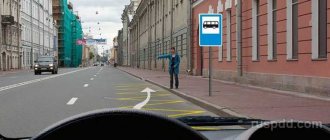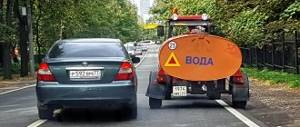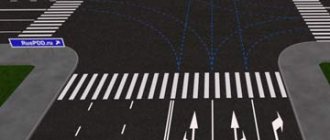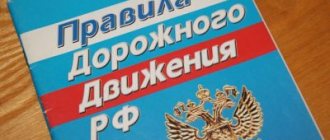Author: ARON
17 January 2021 13:20
Community: Autoworld
Tags: traffic rules reminder, markings
8817
5
There is nothing in the traffic rules that was done just for fun or for beauty. Especially when it comes to road markings.
0
See all photos in the gallery
For a second, it is the most effective tool for regulating relations between motorists and pedestrians. Yellow markings occupy a special place in the rules today. There are three schemes in which yellow is used as a mandatory color. In another, yellow is the recommended color.
What types of road markings exist by color and their designations
All types of road markings are divided into two large groups:
- constant;
- temporary.
Another criterion used to separate this type of designation is the color of the paint applied to the asphalt. To make the signs on the road more visible and more contrasting, white is used, however, in some cases lines of yellow, orange, blue and other colors are used.
According to the requirements of GOST 51259-2018, the following colors can be used on the roadway:
- White and yellow - to create noticeable dividing lines separating oncoming and passing flows. Yellow is more visible under a layer of snow or in bad weather conditions. Also, this shade is used to make “waffle irons” at intersections, places with prohibited parking and to mark pockets for public transport.
- Blue - used to delimit traffic in areas of multi-lane intersections and determine the boundaries of parking lots. The priority of this marking is determined not by its color, but by its shape: only a broken line can be crossed with impunity.
- Orange – used for temporary delimitation of traffic lanes. Used during repair work and has priority over road signs.
- Black - applied exclusively to vertical structures (curbs and pillars), not for lines on asphalt.
Is there a difference between yellow solid and white solid
Both white and yellow solid are considered permanent markings that regulate the rules at stops and parking areas. Solid white, 1.1, is applied to the parking space and indicates the boundaries of the box where the driver can place the vehicle.
In addition to this purpose, 1.1 is used on the roadway: it separates traffic flows in oncoming directions and marks the boundaries of the roadway. In both cases, line 1.1 is prohibited from crossing.
What should the yellow markings be like?
If yellow markings belong to the category of permanent designations, then they may indicate:
- pockets designed for boarding/disembarking public transport passengers;
- places where parking and stopping of vehicles is prohibited, in addition to signs 3.27 and 3.28;
- manholes, storm drains and drains on the roadway (extremely rare).
Types of road markings
The yellow line on the asphalt can be made in several ways:
- Solid. It is used to mark the roadside and is applied 20 cm from curbs or sidewalks for pedestrians. Used for places where parking of vehicles is prohibited, together with the signs “Stopping is prohibited” and “Parking is prohibited”. Occasionally used as a stripe to separate oncoming traffic (similar to a solid white line). The latter option is used in regions with snowy winters for better visibility.
- In the shape of a zigzag. According to paragraph 1.17 of the traffic rules, a broken line indicates the location of a public transport stop. For other road users, parking in the specified zone and 15 meters from it is prohibited. Also, reversing and turning around are prohibited in this area.
- Broken line. When applied on the roadsides and edges of the sidewalk, it means a parking ban (clause 1.10 of the traffic rules). On country roads, such a sign on the right side prohibits driving on the side of the road.
- In the form of squares or “waffle irons”. They are used only at the intersection of roadways to indicate a zone where stopping is prohibited.
Application options
Yellow markings can be applied as follows:
- horizontally - this group includes all types of markings on asphalt: solid, broken and broken lines;
- vertically. Yellow color is used in this way extremely rarely. It can indicate dangerous areas (protruding hatches or poles), and the yellow color can be applied to curbs.
What do yellow markings on the road mean according to traffic regulations?
Every driver of a vehicle must remember which signs are used to comply with the rules on the roads, their compliance with traffic rules, certain GOST, among other things.
There are also yellow markings on the road. What does a line on asphalt mean? It helps to navigate the path in the dark and is used with other signs. The lines on the road surface come in three colors: yellow, white, orange.
The latter is used as a temporary marking, usually when carrying out repair work.
Functions of road markings: informs about approaching road signs, dangerous sections of roads, separates traffic lanes, complements the requirements of road signs. Let's look at what yellow markings on the road mean according to traffic rules.
The horizontal line serves as a separator for traffic flows moving in opposite directions, having two or three lanes, as well as a delimiter of roadway zones to which entry is prohibited. Horizontal markings are used in parking lots. It is prohibited to cross it.
Designation in yellow
Not all motorists give the correct answers in exams when answering the question of what yellow markings on the road mean. Many people take it for temporary, but it is permanent and acts as a type of horizontal.
Typically, the yellow line is a guide for minibuses and other types of passenger transport. It can also be seen in areas of wastewater or manholes. Some areas with it are equipped with special reflectors.
solid line
Solid yellow markings along the road separate traffic flows from opposite directions and indicate dangerous boundaries of traffic areas and the boundaries of roads for which entry is prohibited. It marks the boundaries of the parking area.
It is prohibited to cross it, but only to stop transport on the side of the road, when leaving it in permitted places for the purpose of parking or stopping.
Let's look at what yellow markings on the road mean. Solid is usually combined with the corresponding sign. It is applied along curbs, roadsides at a distance of 20 cm to the edges of the roadway and prohibits stopping vehicles, duplicating the prohibitory stop sign.
A double solid line acts as a separator for traffic flows in opposite directions into four or more lanes. Crossing the markings is prohibited.
The broken line indicates the edge of the carriageway of two-lane roads. When markings have stroke lengths half as long as the gaps, overtaking vehicles is permitted.
The corresponding sign and intermittent yellow markings on the road mean that parking in such areas is prohibited, but stopping or unloading is allowed. The line may be present at the very edge of the road, painted on the curb. Such markings on suburban sections of roads prohibit stopping in the marked area, and violation of the rule will be regarded as driving on the side of the road.
The intermittent line also shows the boundaries of the lanes if there are two or more of them in one direction, and separates traffic flows in different directions, where there are two or three lanes.
Intermittent, the length of the strokes of which is three times higher than the intervals, is a warning that you are approaching a continuous marking.
Intermittent with strokes equal in size to the spaces between them means movement at an intersection.
Wide intermittent is applied to intersections, road intersections, and bus stop areas. Double intermittent at the boundaries of traffic lanes, where reverse control is applied, traffic flows are divided into opposite directions (with invalid reverse traffic lights).
A yellow intermittent sign means no parking, duplicates the prohibition sign, and is placed at the edge of the roadway, along the top of the curb. It is allowed to stop transport for five or more minutes for boarding/disembarking passengers and unloading vehicles.
Zigzag
This type of marking will mean permission for minibus taxis to stop, while other types of transport will be prohibited. An exception may be the disembarkation of passengers, but only if there is free space and no interference with route transport. You cannot make a U-turn on it.
Zigzag markings are applied at the edge of the roadway, as well as in the middle of the road if we are talking about a tram. Depending on its length, one or more vehicles will be able to stop at the same time. Failure to comply with the rules established in connection with the broken line will subject the driver to penalties.
Other types of lines:
- Combined: separates traffic flows of opposite, passing directions, if changing lanes of this marking is allowed from one of the lanes. Crossing is allowed only for the intermittent part of it. In this way, places for turning, entering and exiting parking lots are marked.
- Stop line: used to indicate a mandatory stop at an intersection, requiring you to give way. A mandatory stop section with a simultaneous traffic light prohibition signal is installed with a sign prohibiting movement without stopping at railway crossings.
Requirements for drawing lines
On the territory of the Russian Federation, yellow markings in the center of the road can be applied using any materials that meet the established requirements: paint, thermoplastic, polymer tape that does not protrude more than 6 mm above the road surface. GOST sets the coefficient of adhesion to the surface (25%), as well as the durability of the coloring material (from 6 months).
On roads of all categories, markings are applied to a surface that has been cleared of old paint. In the absence of artificial lighting on the road, the line must be drawn using reflective substances.
Violations
Motorists should understand the purpose of yellow markings on the road and what their application means. Otherwise, vehicles parked in a place other than the designated one, in accordance with traffic rules, can be evacuated and taken to the parking lot.
Fines:
- when crossing a line running along the side of the road outside a populated area, a fine of 1,500 rubles is provided;
- For violation within a populated area there is also a fine of 1,500 rubles. for residents of regions (3000 rubles for Muscovites);
- Parking in a yellow marking zone requires evacuation to a parking lot without the consent of the car owner and payment of a fine for violation (for being in a prohibited parking lot).
Source: https://FB.ru/article/364541/chto-znachit-jeltaya-razmetka-na-doroge-po-pdd
Do cameras record violations of road markings?
In modern conditions, there are two types of offenses related to crossing yellow markings, which are recorded by automatic cameras:
- Exit and drive along the side of the road marked with a yellow line. In this case, the type of shoulder does not matter: asphalt or unpaved. Thanks to the cameras, the number of drivers who avoid traffic jams on the side of the road is reduced. The fine for such a violation is 1,500 rubles.
- Departure and stop at the “waffle iron”. Stopping at the intersection is prohibited; markings of intersecting yellow lines are used to indicate the area where the restriction applies. In order for such a stop to be considered an offense, it is necessary to leave or not have time to leave the marked area after the activation of the prohibitory traffic light signal. The penalty for violators of this rule is 1000 rubles.
Waffle iron markings
In 2021, from the end of April, changes came to the rules. After some time, the “waffle iron” will be applied in all cities. Turning to the traffic rules, we can say that the driver who stops for it will definitely receive a fine, and a rather large one.
About 30 meters before the “waffle iron” you can see a warning sign. It is very easy to recognize - on a dark background there is a square with two intersecting lines.
If a motorist, without paying attention, nevertheless drives into the markings, then a fine will be applied to him. At each intersection with this marking, a camera is installed that records offenses. Thanks to the “waffle iron,” it is planned to relieve traffic congestion.
Possible fine for violation
For violation of yellow marking requirements, administrative liability is provided:
- intersection of a single line (solid or broken). In Moscow or St. Petersburg it is punishable by a fine of 3,000 rubles; in other regions of Russia the fine is 1,500 rubles. For parking in this area, the violator’s car may be towed to the impound lot;
- for ignoring the benefits of public transport that departs from a broken line (stop) - a fine of 500 rubles;
- ignoring traffic rules requirements to give way to pedestrians crossing the road along a yellow zebra crossing - a monetary penalty of 1,500 rubles;
- turning around or reversing in an area marked with a zigzag - 500 rubles;
- overtaking on a yellow zebra crossing, crossing a solid line dividing traffic flows - a monetary penalty of 5,000 rubles or deprivation of the right to drive for up to six months;
- leaving and stopping at a “waffle iron” at a prohibiting traffic light – a monetary penalty of 1,000 rubles;
- leaving and driving along the side of the road while ignoring the yellow line on the right edge - a fine of 1,500 rubles.
Yellow markings on the road, on the side of the road, along the curb: what does it mean?
Novice drivers and experienced motorists know very well that road traffic is regulated by special signs, and markings are not only permanent, but also temporary. Its main colors are yellow, white and orange.
But for beginners it is not always clear - what do yellow markings on the road mean? The rules state that white and yellow markings are used as permanent markings; the temporary stripe is drawn in orange.
Fines and other unpleasant situations can be avoided if you know what the yellow markings along the curb mean.
What does the yellow line on the road mean?
What do yellow markings on the road mean? Road markings are a special designation that is used to guide both cars and pedestrians. Thanks to this method, traffic zones are demarcated, parking areas are designated, and the like.
The horizontal plan is marked in two primary colors: white and yellow. Of course, the second option is more often used. There are 3 types of these.
Yellow road markings indicate:
- a specific place where you can stand and stop;
- area of the road on which stopping of vehicles is prohibited.
A car owner who sees markings of this color can come to the very simple conclusion that special rules apply here. Almost always this is a ban on both parking and stopping, except for special vehicles.
These lines are marked by special services. They do this according to certain GOST standards both in cities and on high-speed highways.
What types exist
Each motorist, after reading this information, will be able to draw certain conclusions for himself and characterize any yellow lines on the road.
Let's look at each of them separately:
- A solid single line - it can be seen from the edge of the roadway, it is located on top of the curb. It is always located in parallel. Yellow markings on the road along the side of the road prohibit stopping and parking of vehicles. Very often this line can be seen next to the “No Stopping” sign installed at the side of the road. In this case, the sign will end its action where the marking ends.
- Broken yellow marking line - located and applied in exactly the same way as the first type. A yellow broken line marking on the side of the road means that parking on this road section is prohibited, but stopping is permitted. A motorist can stop next to the dotted line for about 5 minutes, but only if he is boarding/disembarking passengers or unloading/loading cargo. The markings can be used in conjunction with the “No Parking” sign.
- Yellow “zigzag” - only minibuses or passenger taxis can stop on this section of the road.
Passenger cars are prohibited from standing or stopping in this place, as well as in the areas before and after this marking. In addition, you cannot make turns or drive in reverse. The car owner must give way to minibuses that are leaving the stop.
These 3 types of markings are basic; they can be seen in absolutely any city and place.
Waffle iron markings
In 2021, from the end of April, changes came to the rules. After some time, the “waffle iron” will be applied in all cities. Turning to the traffic rules, we can say that the driver who stops for it will definitely receive a fine, and a rather large one.
About 30 meters before the “waffle iron” you can see a warning sign. It is very easy to recognize - on a dark background there is a square with two intersecting lines.
If a motorist, without paying attention, nevertheless drives into the markings, then a fine will be applied to him. At each intersection with this marking, a camera is installed that records offenses. Thanks to the “waffle iron,” it is planned to relieve traffic congestion.
What fine can be applied
Surely every car owner is interested in knowing what fines are applied for parking or parking in the wrong place on yellow lines.
Current fines for violating yellow markings:
- If a continuous or intermittent single yellow marking is violated, the car owner will be fined 1,500 rubles, and in Moscow and St. Petersburg - at least 3,000 rubles. But that's not all - the car is also towed to the impound lot.
- If, while driving past a zigzag, a motorist does not give way to a minibus, then he will also be fined in the amount of 500 rubles.
- If a pedestrian moves along a yellow zebra crossing and the car owner does not let him through, the fine will be 1,500 rubles.
- If the driver stops close to a pedestrian crossing or a stop, a fine will be applied in the amount of 1000 rubles, in Moscow and St. Petersburg - 3000. The vehicle is also evacuated to the impound lot.
- A fine of 500 rubles is applied if a motorist turns around or starts moving in reverse on a pedestrian zebra crossing.
- If a motorist overtakes at a pedestrian crossing, he will face a fine of 5,000 rubles or even deprivation of his driver’s license for a period of 4 to 6 months. If the violation was committed repeatedly, then up to 12 months.
We can conclude that for violating the marking lines, the fine varies from 500 to 5000 rubles, or the motorist is completely deprived of his driver’s license for up to a year.
Do cameras record violations of road markings?
Cameras help traffic police officers track offenders on the roads, that is, thanks to them they can record speed and other violations. The camera helps resolve many controversial situations. So, if you study the statistics, then approximately 32% of the offenses recorded by the camera turn out to be false.
A lot of things affect how a camera works. Therefore, it may fail. This could be weather conditions or any current situation. First, the device records the speed of the car. After this, the system calculates how fast he was moving.
Even the newest cameras, manufactured using modern technologies, can malfunction and provide false information.
This may be due to the following reasons:
- the machine is faulty;
- repair work is being carried out;
- the passage is littered with construction materials;
- there are any unevenness on the road surface.
It often happens that the shadow of a vehicle, which fell on a solid line, was displayed on the cameras and the system considered this a violation, while recording the license plate number of the car. This recording is considered an error, so no fines will be applied to the motorist.
Electronic fines are processed manually by traffic police officers. Therefore, the risk of the presence of a human factor is also possible.
The Strelka radar is capable of calculating not only the speed at which vehicles are moving, but also recording the intersection of a solid line. Moreover, it is installed not only on a permanent basis, but also on a temporary basis, using tripods.
If the line is not visible, is the penalty applied?
Any markings may be covered with snow or may be erased in high-traffic areas. Many motorists wonder whether the fine imposed in this case is legal.
In order to understand this issue, it is necessary to take into account several circumstances:
- If there are four or more lanes on the roadway, the markings of which are poorly visible due to snow or other conditions, the driver is responsible for making an independent decision about the correct placement of his vehicle on the road. In this case, a fine will be imposed for violating the traffic rules.
- If the road has less than four lanes and there are no additional road signs, then imposing a fine in this situation is unlawful.
In order to challenge the punishment imposed by the traffic police inspector, you must warn the employee of your disagreement with his decision and make a corresponding note in the protocol. Subsequently, you will need to provide evidence of your innocence during the trial.
| Did not find an answer to your question? Call a lawyer! Moscow: +7 (499) 110-89-42 St. Petersburg: +7 (812) 385-56-34 Russia: +7 (499) 755-96-84 |
For the last few years, yellow markings on Russian roads have been used along with white markings. Such lines on the asphalt can prohibit parking, delimit traffic flows and indicate an area at an intersection where stopping is prohibited. For violation of these requirements, drivers are subject to a fine.
What is yellow road marking used for?
The use of yellow markings is due to several factors affecting road safety:
- Identification of marking lines on roads with high congestion and poor visibility, especially in areas with a lot of fog.
- Duplication of road signs installed in dense urban areas.
- Identification of places with special traffic conditions, when the use of appropriate road signs is impossible due to the lack of places for their installation.
Yellow solid line
A solid yellow one, applied in the middle of the roadway, is used instead of an orange dividing strip and warns drivers about repairs or other types of work.
What does a solid yellow stripe on a road or curb mean? This means that stopping or parking vehicles on this section of the road is strictly prohibited, which is equivalent to the requirements of road signs 3.27 and 2.28. In the same way, a yellow solid line is drawn at the edge of the roadway on the highway, which indicates the area where vehicles are prohibited from leaving the road and stopping on the side of the road, with the exception of those few cases indicated in the traffic rules, when further movement may be dangerous due to driver condition or vehicle malfunction.
According to the new GOST, which will come into force in 2021, a solid yellow line is used to separate traffic flows and indicate places where overtaking and changing lanes are prohibited in the middle of the road. Similar to a single one, a double yellow solid one can be used to separate oncoming traffic on roads with two or more lanes in one direction. Next to one solid yellow line, a dashed line of the same color is also visible.
The latest innovation from the developers of GOST R 51256-2018: it was allowed to apply markings of yellow solid lines crossing each other at intersections where crossing its border is prohibited during a traffic jam at the intersection itself or immediately beyond it.
